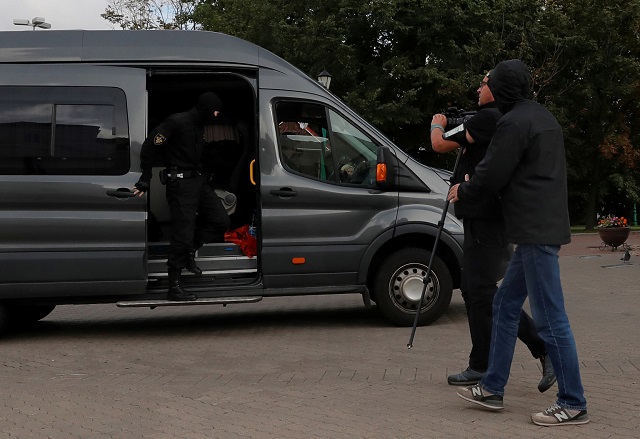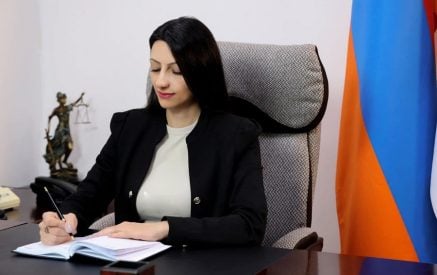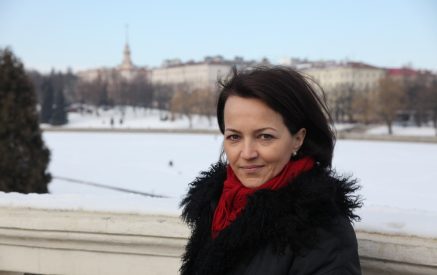By Gulnoza Said/CPJ Europe and Central Asia Program Coordinator
The images coming out of Belarus look like scenes from a blockbuster film: A president clinging to power striding out of a helicopter holding a Kalashnikov assault rifle, while his gun-toting teenage son and heir apparent walks alongside him in a helmet and military vest; the protesters calling for the president’s removal singing songs, playing music, and taking off their shoes to stand on benches on the streets of Minsk and other cities; women with long waving hair and flower crowns hugging and kissing heavily equipped riot police as a gesture of peace and solidarity; workers striking and resigning from government jobs. The journalists who have taken these pictures and brought the stories behind them to the world’s attention have done so through sweat and blood.
The country’s August 9 presidential election, which saw incumbent Aleksander Lukashenko win 80 percent of the vote according to the official tally, has been deemed illegitimate by many voters and the opposition, according to news reports. With a historic uprising underway, Belarusian authorities have used numerous methods to try to quash the country’s biggest story in recent memory. Below are four press freedom trends to watch amid the ongoing protests.
1. More journalists detained
Read also
In the first few weeks of protests, Belarusian authorities detained dozens of journalists at the notorious Akrestsina detention center; some returned with stories of brutal treatment. As international condemnation mounted, on August 12 the minister of interior instructed riot police not to “touch” the press. But the detentions have started again; on August 27 the Belarusian Association of Journalists documented 47 arrests. After the reporters’ documents were checked, most were released without charges on the condition that they delete all photos and videos they took at the protests, BAJ deputy head Barys Haretski told CPJ. Those who refused were threatened with lengthy prison terms, he said.
Four remained in custody overnight, said Haretski. They were: Belsat correspondents Katsaryna Andreyeva and Maksim Garchanok, freelance photojournalist Alyaksadnr Vasyukovich, and Andrei Yarashevich, a camera operator of Current Time, an online video project of U.S. Congress-funded broadcaster Radio Free Europe/Radio Liberty. After they refused to delete their protests footage, said Haretski, they were charged with “participation in unsanctioned protests,” according to BAJ and Current Time. If found guilty, they could face an administrative arrest or fines, according to the same sources.
One journalist was deported, BAJ reported. Award-winning Swedish photojournalist Paul Hansen was arrested on August 27 and sent to Sweden the following day. The deportation order against him is valid for five years, according to news reports.
On August 27, the ministry of interior issued a statement that “the journalists were summoned (not detained!) to check their documents that prove the legality of their professional activities.” The ministry added that “the journalists of registered media outlets as well as foreign journalists accredited with the foreign ministry will be released.”
CPJ’s email to the ministry of interior went unanswered.
2. A slowdown in publishing for print outlets
A few days into the protests, the Belarusian state publishing house started refusing to print independent newspapers, sending outlets scrambling to find alternative ways to get their reporting to the public.
The liberal daily Komsomolskaya Pravda v Belarusi, which has covered the protests and the police response, was denied access to the publishing house from August 18 through August 22, according to the outlet’s general director Natalya Galeznik, who spoke to business news site Marketing.by.
“The [state] printing house kept citing technical reasons – either the machines were broken, or they ran out of materials necessary for printing,” Galeznik said.
Maryia Sadouskaya-Komlach, a Poland-based journalist and press freedom advocate and a native of Belarus, told CPJ via a messaging app that she doubted that explanation.
“The newspapers wanted to print a white-red-white flag that became a symbol of anti-Lukashenko protests. On the same day, the same printing house was able to print another, state newspaper, that had an interview with a pro-Lukashenko singer,” she said.
In the wake of the shutdown, Galeznik said the paper’s PDF version skyrocketed in popularity, selling more than 50 times its normal amount. Eventually, the paper was able to find a printer in Russia and sell newspapers at private and state-owned kiosks in Belarus.
But now the newspaper is under renewed scrutiny; on August 26, the Committee of State Control and the state tax service sent inspectors to its offices, according to reports, which said inspectors will stick around until October 10.
Other independent newspapers have had similar experiences: Narodnaya Volya, Svobodnye Novosti Plus, and BelGazeta were blocked from the state publishing house, according to media reports and BAJ. Narodnaya Volya tried to print in Russia and deliver the paper in Belarus, but the state postal service BelPoshta did not distribute it inside the country, according to BAJ and media reports.
CPJ phoned and emailed the state printing house, but nobody picked up the phone or responded.
3. Websites blocked and the internet turned off
Since August 9, websites for some of the largest news outlets are no longer accessible in Belarus as dozens of sites have been blocked, according to news reports. They include: Belsat, an independent broadcaster; Euroradio, a Poland-based radio station; Radio Free Europe/Radio Liberty, known locally as Radio Svaboda, a U.S. Congress-funded broadcaster; and Mediazona-Belarus, the Belarus project of an independent Russian outlet that reports on the press. Users have also reported difficulties accessing YouTube, as well as messaging platforms such as Viber and email service ProtonMail, according to media reports.
Lukashenko is blaming outside forces. On August 10, he said the internet was being “blocked from abroad in order to cause discontent among the people” and added that his “specialists are trying to figure out where this blocking was initiated,” according to state news agency BelTa.
In the meantime, many online media outlets have switched to the messaging app Telegram to share news and information and coordinate activities. Telegram founder Pavel Durov announced August 10 on Twitter that the platform had deployed an “anti-censorship tool” in the country but “the connection is still very unstable as internet is at times shut off completely in the country.”
Indeed, there have been reports of full internet shutdowns. From August 26 to 27 mobile operators shut down internet connections per government orders, human rights media outlet Charter 97 reported. The internet was only reinstated after protests at Nezalezhnastsi and Svaboda squares in Minsk were dispersed, according to reports.
CPJ’s calls and emails to the information ministry’s main department and the department that oversees internet-based media outlets went unanswered. CPJ also emailed Belarus’s National Computer Emergency Response Team, an agency that tracks network attacks in the country, but did not receive a reply.
4. The rise of radio as an alternative
With print outlets and websites struggling to publish, Belarusians are relying on the radio for news. Radio Svaboda, which broadcasted via the internet until it was blocked, resumed its broadcast on medium waves on August 12, according to reports. And on August 21, Polish public broadcaster Polish Radio S.A. announced the launch of long-wave broadcasts for Belarus three times a day and described it as a “support for the Belarusian people in these difficult times, [a] gesture of solidarity in the form of reliable and truthful information.”
CPJ’s Russia and Belarus correspondent Valentinas Mite contributed to this report from Vilnius, Lithuania.
Gulnoza Said is a journalist and communications professional with over 15 years of experience in New York, Prague, Bratislava, and Tashkent. She has covered issues including politics, media, religion, and human rights with a focus on Central Asia, Russia, and Turkey.
Committee to Protect Journalists
Caption: Law enforcement officers detaining a journalist who was on assignment are photographed by a Reuters photographer shortly before his detention, in central Minsk, Belarus August 27, 2020. The detention of journalists is just one method authorities are using to crack down on the press. (Reuters/Vasily Fedosenko)





























































